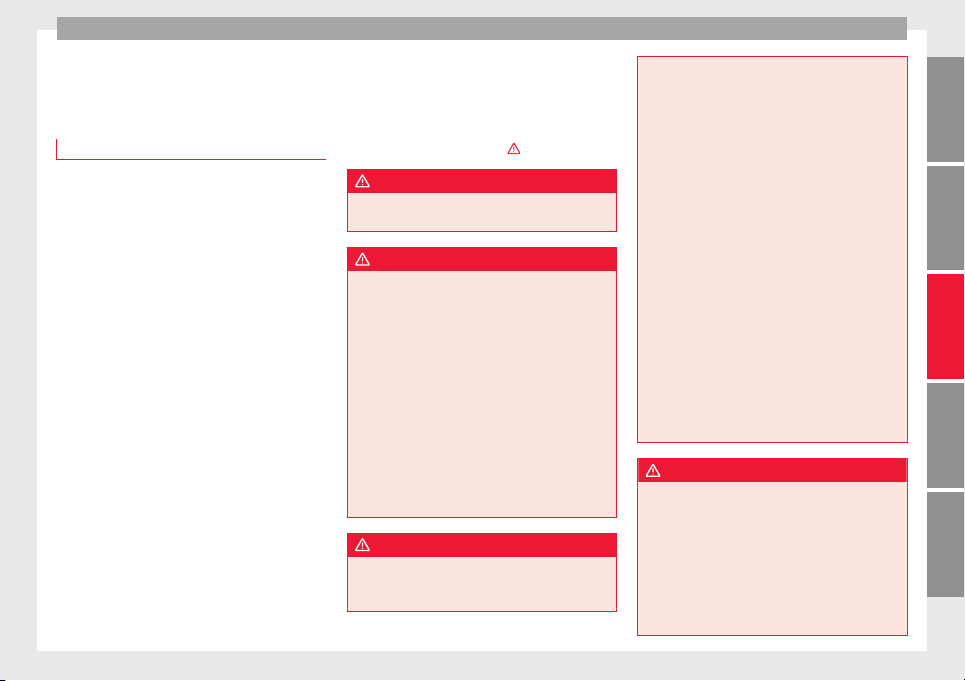Loading ...
Loading ...
Loading ...

Towing bracket device
Towing bracket device
Driv
in
g w
ith a trailer
Introduction
Always be aware of the legal requirements for
each c
ountry to drive with a trailer and to use
a tow hitch.
Your car is intended mainly for transporting
passengers however, it can also be used to
tow a trailer provided that it is fitted with the
necessary equipment. The additional load
has an effect on the useful life, fuel con-
sumption and the vehicle performance and,
in some cases, reduce the service intervals.
Driving with a trailer requires more force from
the vehicle and, thus, more concentration
from the driver.
For wintertime temperatures, fit winter tyres
to the vehicle and the trailer.
Drawbar load
The maximum permitted Drawbar load exer-
ted by the trailer drawbar on the ball joint of
the tow hitch must not exceed 100 kg (ap-
proximately 220 lbs).
Vehicles with the Start-Stop function
With a SEAT factory fitted or retrofitted tow
hitch, the Start-Stop function is automatically
deactivated when a trailer is connected. For
tow hit
ches not installed by SEAT, the Start-
Stop function must be deactivated manually
using a button located on the dash panel be-
fore driving with a trailer and it must remain
off for the entire journey ›››
.
WARNING
Never transport people in a trailer: this will
endang
er in their life and is against the law.
WARNING
The incorrect use of the tow hitch can cause
accident
s and injury.
●
Only use a tow hitch in perfect condition
and correctly installed.
●
Never change or repair a tow hitch.
●
To reduce the risk of injury in case of a re-
versing collision, injury to pedestrians and
cyclists when parking, always keep the ball
joint in when a trailer is not being used.
●
Never fit a trailer tow hitch “that distrib-
utes the load” or “balances the load”. Your
vehicle has not been designed for this type of
tow hitch. The tow hitch may fail and the
trailer will separate from the vehicle.
WARNING
Driving with a trailer and transporting heavy
or larg
e objects can affect vehicle handling
and even cause an accident.
●
Alwa
ys secure loads correctly with suitable
and undamaged attachment rope or straps.
●
Adjust your speed and driving style to visi-
bility, road, traffic and weather conditions.
●
Trailers with a high centre of gravity can
overturn more easily than those with a low
centre of gravity.
●
Avoid brusque manoeuvres and sudden
braking.
●
Always take the following precautions seri-
ously.
●
Reduce your speed immediately if you ob-
serve the trailer rocking from side to side.
●
Never drive at more than 80 km/h (50 mph)
when towing a trailer (or 100 km/h [62 mph]
in exceptional circumstances). This also ap-
plies in countries where higher speeds are
permitted. Always take the speed limits for
vehicles with and without trailers in each
country into account.
●
Never try to stop the “snaking” by increas-
ing speed.
WARNING
When driving with a trailer and using a tow
hitch th
at was not installed by SEAT, the
Start-Stop function must be manually deacti-
vated. Otherwise, this could cause a braking
anomaly that could result in an accident with
serious consequences.
●
Always manually deactivate the Start-Stop
function when a trailer is being used on a tow
hitch that has not been installed by SEAT.
»
237
Technical dataAdviceOperationEmergenciesSafety
Loading ...
Loading ...
Loading ...